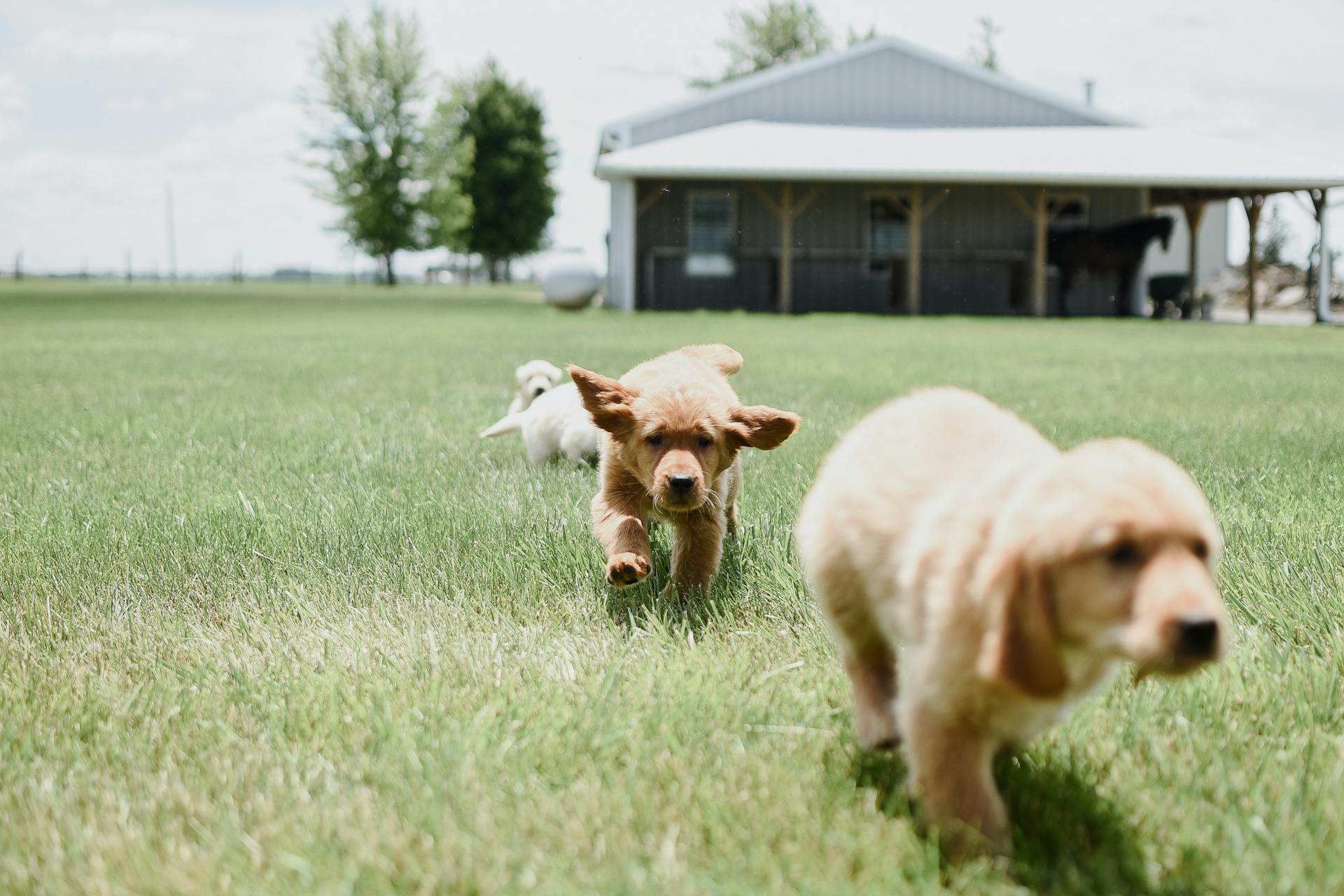
Dogs eating moles can be a real concern for pet owners, as it poses health risks to both the dog and the mole. Moles can carry diseases like leptospirosis and tapeworms.
Dogs can contract these diseases through contact with infected mole tissue. This is especially true if the mole has been killed by the dog's bite or scratch.
Some moles can also cause intestinal blockages in dogs if they are not digested properly. This can lead to severe health complications.
What to Do When Your Dog Kills a Mole
If your dog kills a mole, quickly evaluate the scene to establish whether or not the dog has killed and eaten the mole.
You should locate the dead mole and check to see if your dog is okay.
If your dog is bleeding, it may be due to injuries it sustained from the bites and sharp claws of the mole.
Veterinarians advise that it's healthy to let your pet play and interact with nature, but it's always wise to stay vigilant as a pet owner.
Your dog's hunting instincts can be triggered by a mole scampering away at a distance, and this can be an opportunity for your dog to flex its muscles.
Health Risks for Dogs
If your dog kills and eats a mole, they risk exposure to parasites and diseases carried by the mole.
Moles can carry parasites on and inside their bodies, and their feces harbor harmful bacteria. If ingested, moles have sharp claws that may cause serious injury to the dog's mouth and throat.
Dogs can also get an upset stomach if they eat a mole after killing it, causing signs of vomiting, diarrhea, constipation, straining to defecate, or even a blockage of the stomach or intestines in smaller dogs or those who swallowed the carcass whole.
Fortunately, the risk of rabies is low to negligible, but it's essential to keep your dog up to date on their vaccines, especially for rabies, and use veterinary-approved flea-and-tick treatment regularly to prevent diseases like Lyme and anaplasmosis.
Call Your Vet
If your dog eats a mole, the next thing you should do is call your veterinarian. Tell your vet what happened in as much detail as possible, including whether the mole was living or dead and if there was a fight between your dog and the mole.

If the mole was dead, estimate how long the mole has been deceased. Your vet will recommend your next course of action based on the mole and your dog's symptoms.
Your vet may ask you to bring your dog for an emergency visit, or they may instruct you to monitor your dog's condition yourself. Actions like inducing vomiting should only be performed with your vet's guidance.
Ask your vet for an intestinal parasite screening, as moles can also be common vectors for these.
Do Moles Transmit Diseases to Dogs?
Moles can carry diseases that can be transmitted to dogs. This is because moles collect impurities from their environment, including parasites, viruses, and bacteria.
If your dog interacts with an ill or parasite-infested mole, they are likely to get sick too. This is a risk if the mole is sick or has parasites.
Dogs are at risk of contracting illnesses if they kill and eat a mole. These illnesses can include parasites, viruses, and bacteria that the mole has picked up.
It's essential to stay vigilant as a pet owner and monitor your dog's behavior around moles. A mole scampering away at a distance can trigger your dog's hunting instincts, but it's crucial to be aware of the potential risks involved.
Tapeworms
Tapeworms can be a real concern for dogs that eat moles. Moles are known to harbor parasites in their skin and bodies, and tapeworms are one of them.
If your dog kills and eats a mole, it may ingest tapeworms that live inside the dead mole. These tapeworms can thrive in your dog's digestive system for months without being detected.
Tapeworms can cause serious health issues for dogs, but the good news is that they can be treated with medication. However, it's essential to catch the infestation early to prevent long-term damage.
My Dog Killed a Mole – Will He Get Sick?
As a pet owner, it's natural to worry about your dog's health after they've killed and eaten a mole. Fortunately, there isn't a huge health risk to your dog if they are fully vaccinated and treated for parasites.
However, the risk of rabies is very low to negligible, but medical professionals suggest that moles are very unlikely to transmit rabies. Dogs can also get an upset stomach if they eat a mole after killing it, which may cause signs of vomiting, diarrhea, or constipation.
It's essential to make sure your dog is up to date on their vaccines before they spend any time outside where they can encounter wild animals or drink stagnant water. Ticks can transmit diseases like Lyme and anaplasmosis, and fleas may carry tapeworms, so use a veterinary-approved flea-and-tick treatment regularly.
If your dog eats a mole, the next thing you should do is call your veterinarian and provide as much detail as possible about what happened. Your vet will recommend your next course of action, which may include bringing your dog in for an emergency visit or monitoring their condition yourself.
Dogs can get intestinal parasites like roundworms from eating moles, which can take a few days to become apparent, so ask your vet about them in advance.
Prevention and Mitigation
Dogs eating moles is a common problem that can be prevented with the right knowledge and techniques.
The first step in preventing dogs from eating moles is to remove the attractants that draw them to the moles in the first place. According to our research, moles are attracted to areas with loose soil, which is often found in yards with poor drainage.
Regularly aerating and fertilizing your lawn can help to improve drainage and reduce the likelihood of mole activity. This can also help to promote healthy root growth, making your lawn less appealing to moles.
By reducing the number of moles in your yard, you can also reduce the likelihood of your dog eating them. One effective method is to use traps that are specifically designed to catch moles without harming them.
Another option is to use repellents that can help to deter moles from entering your yard in the first place. These can be effective, but they may need to be reapplied regularly to maintain their effectiveness.
Keeping your yard clean and free of debris can also help to discourage moles from making themselves at home. Regularly raking leaves and clearing weeds can help to reduce the number of hiding spots for moles.
By taking these steps, you can help to prevent dogs from eating moles and reduce the risk of disease transmission and other problems associated with mole eating.
Understanding Mole Behavior
Moles are solitary animals and typically only come out of their underground tunnels at night.
They have poor eyesight but a keen sense of smell and hearing, which helps them detect predators.
Moles are also very territorial and will fiercely defend their underground tunnels and surrounding area.
Their tunnels can extend several feet underground and have multiple entrances and exits.
Moles are herbivores and primarily feed on underground plant material, such as roots and tubers.
Their diet consists mainly of earthworms, but they also eat other invertebrates like insects and snails.
Moles can dig complex tunnel systems with multiple entrances and exits, often with a main tunnel and several smaller branches.
Their tunnels can be up to 20 feet long and have a diameter of about 2-3 inches.
Moles typically live for 1-3 years in the wild, although their lifespan can vary depending on various factors like food availability and disease.
Poisonous Mole Control
If you have a mole problem, it's essential to know how to safely and effectively control them.
Moles can be poisonous, and their bodies contain a toxic secretion that can harm dogs if ingested.
Some moles can carry diseases like leptospirosis, which can be transmitted to dogs through their urine.
Dogs that eat moles are more likely to develop gastrointestinal problems, such as diarrhea and vomiting, due to the mole's toxic secretion.
To prevent your dog from getting sick, it's crucial to remove the mole's tunnel system, which can encourage them to dig and eat moles.
If you have a large yard, consider using a physical barrier to prevent moles from entering the area.
Frequently Asked Questions
Can dogs get sick from eating voles?
Dogs may experience digestive upset, such as vomiting or diarrhea, after eating voles, but toxic or life-threatening effects are unlikely
Should I be worried about moles on my dog?
Most moles on dogs are harmless, but it's always best to have them checked by a vet to rule out any potential health issues
Sources
- https://welovedoodles.com/can-dogs-eat-moles/
- https://fluffyplanet.com/my-dog-killed-ate-a-mole-will-he-get-sick/
- https://www.hepper.com/my-dog-killed-a-mole/
- https://wdfw.wa.gov/species-habitats/living/species-facts/moles
- https://www.canr.msu.edu/news/reduce_lawn_and_garden_damage_caused_by_moles_skunks_and_raccoons
Featured Images: pexels.com


